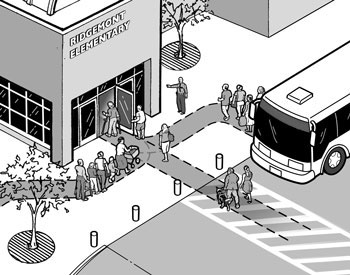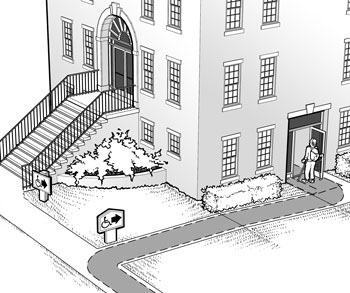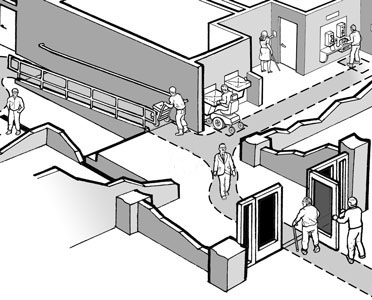| U.S. Department of Justices Civil Rights Division Disability Rights Section |
|
Expanding |
Accessible Information Exchange: |
| Your Market |
Meeting on a Level Playing Field |
|
Introduction Meetings between businesses and people with disabilities - whether related to researching customer preferences, developing a business education curriculum, or discovering effective ways to comply with the ADA - can result in innovative ideas and powerful collaborations that bring greater access to customers with disabilities and attract new customers to businesses. Expanding Your Market: Gathering Input from Customers with Disabilities For these meetings to be successful, everyone involved must have an equal opportunity to participate. Three components are key to presenting meetings that are accessible to people with disabilities: where the meeting is held, how the meeting room furniture is arranged, and how the meeting information is communicated. Event organizers will find that when these elements are accessible, they serve not only the participants with disabilities but also a wide range of others, including older adults, baby boomers, and people with temporary disabilities. Accessible Meeting Location People attending a meeting are concerned about where to find parking, the building entrance, the meeting room, and restrooms. People with disabilities are no exception. Accessible meeting locations are of primary importance to people with mobility disabilities; accessible locations also ensure easier movement for people who are blind or have low vision. Minimum requirements for an accessible temporary event include the following accessible elements: parking; route to the building entrance from accessible parking spaces, drop-off areas and other accessible elements (e.g., route from a bus stop) within the site; building entrance; route to the meeting room; meeting room; and restrooms. Evaluating the Accessibility of a Meeting Site |
When people with disabilities and business owners talk in a friendly forum, collaboration, not litigation, is the likely result. |
Accessible Room Set-Up
Once an accessible site is selected, it is essential that the meeting room furniture be arranged to allow everyone to fully participate. An accessible floor plan is one in which people who use mobility devices (e.g., wheelchairs, scooters, walkers, crutches, canes) can maneuver throughout and use the amenities independently; people who are blind or have low vision can navigate easily and safely; people who are deaf or have hearing loss can use assistive listening systems and see speakers, interpreters, and captioning; and all participants feel comfortable and ready to be engaged in discussion. Arranging an Accessible Meeting Space
Accessible Presentation of Meeting Content
Accessible meetings create a level playing field for participants with disabilities. Accessibility allows people with disabilities and businesses to share their expertise and creativity and to improve the experience for everyone. |
Arranging an Accessible Meeting Space
This list of reminders can serve as a guide to creating accessible meeting room floor plans.
|
Presenting Meeting Content Accessibly
This list of reminders can serve as a guide to presenting meeting content in an accessible way.
|
Providing Auxiliary Aids and Services
A meeting that is accessible to people with sensory disabilities enables them to understand the meeting's presentations and to participate in the discussions.
|
Evaluating the Accessibility of a Meeting Site
A meeting site that is usable by most people with disabilities has, at minimum, the following six accessible features: Feature 1 Feature 2 Feature 3 Feature 4 Feature 5 Feature 6 |
The following descriptions and accompanying images are designed to help determine if a meeting location has the most basic accessible features needed by participants with disabilities. If not, sometimes a temporary modification can be made that will create access for the day of the meeting. It is essential to remember, however, that such temporary access does not relieve facility owners of their continuing obligations under the ADA to remove barriers and provide increased access to people with disabilities after the meeting has ended. Linked to the descriptions of accessible features are several common access barriers and suggestions for removing them temporarily. By reading the descriptions, carefully reviewing the images provided, and considering temporary barrier removal suggestions, organizers can determine whether a meeting place accommodates all participants either as is or with some short-term changes. If a meeting site cannot be made at least temporarily accessible, another site should be selected. To access the legal minimum standards associated with each feature, click on the link in the feature's section to go to the ADA Standards for Accessible Design The Standards are also available on the U.S. Department of Justice website archive.ada.gov or by calling 800-514-0301 (voice) or 833-610-1264 (TTY). |
Feature 1 - Parking and Passenger Drop-Off Areas
When parking is provided for meeting participants, accessible parking must be provided for participants with disabilities. Those who arrive by car or van need an accessible parking space as close as possible to an accessible entrance. The accessible parking space has an adjacent and parallel access aisle that provides needed room for a person to open the car door fully and then to stand with the aid of a walker or crutches, to transfer to a wheelchair, or to lower a wheelchair lift. In order to be usable, the access aisle must be level, clear of gravel or mud, and the surface must be in good condition without wide cracks or broken pavement.
If there is a drop-off area for meeting participants, an accessible passenger drop-off area is also necessary. An accessible drop-off area has a level access aisle that is adjacent and parallel to the vehicle space to serve the same purposes as described above for a parking access aisle.
The access aisles of both the parking space and passenger drop-off area connect directly to an accessible route that leads to an accessible building entrance. When an accessible route crosses a curb, a curb ramp must be provided. ADA Standards for Accessible Design | Temporary Barrier Removal Suggestions for Accessible Features
Feature 2 - Routes to the Building Entrance
There must be at least one exterior accessible route that connects accessible parking spaces and other accessible elements within the site, such as accessible drop-off areas or a route from a bus stop to an accessible building entrance. The accessible route is essential for people who have difficulty walking or who use wheelchairs or other mobility devices to get to the accessible entrance of the meeting site. An accessible route is at least 36 inches wide for the entire length of the route. (It may narrow briefly to 32 inches wide at utility poles, post-mounted signs, street furniture, and doorways.) Abrupt level changes, steps, or steeply sloped sidewalks cannot be part of an accessible route. Where ramps are used, they cannot be steeper than 1:12 (8.33% incline). Ramps with a vertical rise of more than 6 inches must have handrails on both sides. Ramps must also have edge protection to stop crutch and walker tips and wheelchair wheels from slipping off the sides, and level landings at the top and bottom of each segment and where a ramp changes direction.
Wherever possible, the accessible route should coincide with the main route to the building. However, if an accessible route is different from the route used by other participants, signs are required at key decision points to direct participants with disabilities to the accessible route to the building. It is important to note that people who are blind or have low vision may use all routes -- not only the accessible ones -- that lead to a building. Therefore, objects that do not provide sufficient head clearance or that are mounted too high and protrude into a route can become hazards because they cannot be detected by people who are blind or have low vision and use canes. All routes must be free of overhanging objects that are less than 80 inches above the ground. There must also be no objects that protrude more than 4 inches into the route when the bottom edges of the objects are between 27 inches and 80 inches above the ground. Examples of potential protruding objects include handrail extensions on stairs and ramps, post- or wall-mounted signs, outdoor drinking fountains, and low-hanging tree limbs. ADA Standards for Accessible Design | Temporary Barrier Removal Suggestions for Accessible Features |
An accessible meeting location must have at least one accessible entrance that is connected to an accessible route. An accessible entrance must provide at least one accessible door with maneuvering space, accessible door hardware, and enough clear width to allow people who use crutches, canes, walkers, scooters, or wheelchairs to use it. The accessible entrance should be the main entrance whenever possible. If the accessible entrance is not the main entrance to the meeting site, then signs must be located at all inaccessible entrances to direct participants to the accessible one. The accessible entrance must remain unlocked when the meeting is taking place. ADA Standards for Accessible Design | Temporary Barrier Removal Suggestions for Accessible Features |
Feature 4 - Routes to the Meeting Space
The interior accessible route connects the accessible entrance with the meeting space. Typically made up of hallways, corridors, and interior rooms and spaces, the accessible route is essential for people who have difficulty walking or who use wheelchairs or other mobility devices. The accessible route to the meeting space must have the same characteristics as the accessible route to the building entrance. ADA Standards for Accessible Design | Temporary Barrier Removal Suggestions for Accessible Features It is important to note that people who are blind or have low vision may use all routes -- not only the accessible ones -- that lead to the meeting space. Therefore, objects that do not provide sufficient head clearance or that are mounted too high and protrude into a route can become hazards because they cannot be detected by people who use white canes. (See Routes to the Building Entrance for a detailed description.) Items that can become hazards include wall-mounted fire extinguishers, display cases, and sconces, as well as open staircases, overhead signs and banners, and the curved sides of arched doorways. |
The meeting space must have an accessible floor plan. Temporary Barrier Removal Suggestions for Accessible Features | Arranging an Accessible Meeting Space
 |
| An accessible restroom with accessible amenities (e.g, drinking fountains) outside the space. |
If restrooms are available to meeting participants, then accessible restrooms must also be available to participants with disabilities. Accessible restrooms should be in the same basic location as other restrooms. An accessible stall has a door wide enough to enter; floor space for a wheelchair user to roll up to the toilet; grab bars on the back and side wall nearest the toilet to support the person as he transfers from and back to his wheelchair; a toilet seat at wheelchair seat height to facilitate transfer; a flush valve and toilet paper dispenser within reach; and door hardware that does not require tight pinching, twisting, or grasping to use.
An accessible lavatory has floor space in front so that a wheelchair user can approach it, knee clearance so the person can pull under it, and a lowered top surface height so the person can reach the faucets and soap dispenser and use the bowl easily. The lavatory's hot water and drain pipes have to be insulated or configured to prevent leg burns or injuries, and the lavatory may not have sharp or abrasive surfaces underneath. Faucets can not require tight pinching, twisting, or grasping to operate (i.e., they are operable with a closed fist). An accessible lavatory is not necessarily one with an extended, shallow bowl - many different lavatories can work if installed properly. Soap dispensers, paper towel dispensers, hand dryers, and trash cans should be near the sink (but not blocking fixtures or dispensers) and within the reach range of someone who is seated or of short stature. Ensure that furniture (e.g., a chair, a large trash can) does not block maneuvering clearances at doors or fixtures and that hand dryers and dispensers are not mounted where they become protruding objects. ADA Standards for Accessible Design | Temporary Barrier Removal Suggestions for Accessible Features
Temporary Barrier Removal Suggestions for Accessible Features
Feature 1 - Temporary Barrier Removal, Parking and Passenger Drop-Off Areas
| Barrier | Modification |
|---|---|
| Parking is available, but no accessible parking is provided or there are not enough accessible parking or van-accessible spaces. | Find a level parking area near the accessible entrance and designate that area for accessible parking. Use a group of three standard parking spaces to make two accessible parking spaces that are located on either side of an access aisle (which is created from the middle standard space). Traffic cones or other temporary elements may be used to mark the spaces and keep cars from parking in the access aisles. Provide a sign to designate each accessible parking space and make sure the access aisle of each space is connected to the accessible route that leads to the accessible entrance. |
| Accessible parking is provided, but spaces do not have a marked access aisle next to them. | Restripe the accessible parking spaces to provide an access aisle. As a temporary solution for the meeting day, use traffic cones to mark off the access aisle and curb ramp area. The first accessible parking space provided should be a van accessible parking space with an access aisle that is at least 96 inches wide to accommodate a van's wheelchair lift or ramp. |
| Accessible parking spaces, passenger drop-off areas, or access aisles are on sloped surfaces. | Find a level parking area that is close to the accessible entrance. Provide accessible parking spaces and access aisles in that area. Use one parking space next to the accessible parking spaces to serve as an accessible drop-off area. Make sure the accessible parking spaces and drop-off area connect to an accessible route to the entrance. Provide a sign designating each accessible parking space. |
| No sign with the international symbol of accessibility is installed at each accessible parking space. | Provide a temporary sign in front of each accessible parking space. |
| There is insufficient vertical clearance of at least 98 inches (8 feet - 2 inches) for the vehicle route to the parking space, the parking space, the access aisle, and along the vehicle route to the exit for high-top or large vans. | Remove or raise low objects along the route or relocate each van accessible space. |
Feature 2 - Temporary Barrier Removal for Routes to the Building Entrance
| Barrier | Modification |
|---|---|
| The sidewalk connecting parking to the meeting site entrance is too steep to be accessible. | Find another route that can serve as the accessible route or provide parking services or parking in another location (e.g., valet parking). |
| The accessible route crosses a curb and no curb ramp is provided. | Install a portable ramp that has an incline with a slope no steeper than 1:12 (8.33%) with edge protection. |
| One or two steps are part of the walkway leading to the accessible entrance. | Install a portable ramp that has an incline with a slope no steeper than 1:12 (8.33%) with edge protection and handrails, if needed. |
| Branches or other objects over a walkway or pedestrian route are less than 80 inches above the walk. | Prune the branches or remove the items that are hanging below 80 inches. Another approach is to install a detectable barrier under the item that is too low. The detectable barrier must be within the range of 27 inches or lower above the route. |
| One or more objects protrude too far from the side into the circulation path causing a hazard for people who are blind or who have low vision. | When people who are blind or who have low vision use a cane to detect hazards, objects located at 27 inches or lower are detectable. When an object is located more than 27 inches off the ground, it is a hazard if the object protrudes into the circulation path. To make a protruding object detectable:
|
| The undersides of exterior stairs are not enclosed or protected with a cane-detectable barrier. | Add a barrier or enclosure below the stair or relocate the route away from the stair. Enclosing the area below the stair or installing a cane-detectable barrier helps a person who is blind or has low vision stop before hitting her head. |
Feature 3 - Temporary Barrier Removal for the Building Entrance
| Barrier | Modification |
|---|---|
| One or two steps at the main entrance prevent access. | If another entrance is accessible and on an accessible route from accessible parking, install a directional sign at the main entrance directing participants to the accessible entrance. Keep the accessible entrance unlocked during meeting hours. If another accessible entrance is not available, install a temporary ramp with edge protection and handrails. |
| There is a small step at the entrance. | Install a short temporary ramp to provide a smooth transition, with a slope no steeper than 1:12 (8.33%) and edge protection and handrails, if needed. |
| The entrance door threshold has an abrupt change in level of more than 1/4 inch and no beveled sides. | If the threshold is between 1/4 and 1/2 inch high, add beveled surfaces to both sides of the threshold. Or, replace with a new threshold that is no more than 1/2 inch high and has beveled sides. |
| The entrance door to the building is heavy and difficult to open. | Keep the door propped open or station volunteers near the door to open it for participants. |
| The entrance door does not have at least 18 inches of maneuvering clearance on the latch side of the door. | Move whatever is blocking the maneuvering clearance, keep the door propped open, or station volunteers near the door to open it for participants. |
| The door or one side of a double-leaf door at the accessible entrance provides less than 32 inches clear-passage width when the door is open 90 degrees. | Find another entrance with an accessible door, or prop both doors open during meeting times. |
| The door handle and/or latch at the entry door is not accessible. | There are four typical solutions: 1) add an accessible pull or handle to the outside of the door and leave the door unlatched; 2) install an accessible door handle and hardware; 3) leave the door propped in an open position; or 4) have someone open the door. |
Feature 4 - Temporary Barrier Removal for Routes to the Meeting Space
| Barrier | Modification |
|---|---|
| One or more steps along the hallway to the meeting space block access. | Install a portable ramp that has an incline with a slope no steeper than 1:12 (8.33%) with edge protection and handrails, if needed. Or, relocate the accessible meeting to another area that is on an accessible route. |
| The meeting space is not on an accessible route and cannot be made accessible. | Look for another area where an accessible meeting may be presented. |
| Pedestrian routes that lead to or serve the meeting space have objects that protrude from the side more than four inches into the route with the bottom of the object more than 27 inches above the floor. Note: These objects may be wall mounted or freestanding. Items to check include wall-mounted fire extinguishers, light fixtures, coat hooks, shelves, drinking fountains, and display cases. | Place a detectable object on the floor below each object to remove the hazard. |
| Pedestrian routes leading to or serving the meeting space have overhead objects with the bottom edge less than 80 inches above the floor. | Place a detectable object on the floor below each object to remove the hazard. |
Feature 5 - Temporary Barrier Removal for Meeting Space
| Barrier | Modification |
|---|---|
| Routes within the meeting space have objects that protrude from the side into the route with the bottom of the object more than 27 inches above the floor. | Place a detectable object on the floor below each object to remove the hazard. |
| Pedestrian routes leading to or serving the meeting space have overhead objects with the bottom edge less than 80 inches above the floor. | Place a detectable object on the floor below each object to remove the hazard. |
| The room has a fixed stage or platform with one or more steps leading up to it. | Install a portable ramp with edge protection and handrails or a portable lift next to the stage. Or, have all presenters speak from the main floor. |
Feature 6 - Temporary Barrier Removal for Restrooms
| Barrier | Modification |
|---|---|
| There is no accessible public restroom near the meeting space. | Find the nearest accessible public restroom in the building. Determine the shortest accessible route to that restroom from the meeting space and offer specific directions to participants. |
| Dispensers and hand dryers in the restroom are not within reach of someone who uses a wheelchair or scooter. | Place toilet paper, soap, and paper towels on a clean, horizontal surface that is within reach. |
| Hand dryers and dispensers with a bottom edge higher than 27 inches above the floor protrude more than four inches into the route. | Place a detectable object on the floor below each dryer and dispenser to remove the hazard for the meeting day. |
Additional Resources for Technical Assistance and Locating Accessibility Services
Region 1 (CT, ME, MA, NH, RI, VT)
DBTAC: New England ADA Center
Adaptive Environments Center, Inc.
180-200 Portland Street, First Floor
Boston, MA 02114
(617) 695-1225 (V/TTY)
(617) 482-8099 (Fax)
http://adaptiveenvironments.org/neada/site/home
Region 2 (NJ, NY, PR, VI)
DBTAC: Northeast ADA Center
Cornell University
Northeast ADA & IT Center
331 Ives
Ithaca, NY 14853-3901
607-255-8348
607-255-6686 (TTY)
607-255-2763 (Fax)
http://www.ilr.cornell.edu/edi/dbtacnortheast/index.cfm
Region 3 (DE, DC, MD, PA, VA, WV)
DBTAC: Mid-Atlantic ADA Center
TransCen, Inc.
451 Hungerford Drive, Suite 607
Rockville, MD 20850
301-217-0124 (V/TTY)
301-217-0754 (Fax)
http://www.adainfo.org
Region 4 (AL, FL, GA, KY, MS, NC, SC, TN)
DBTAC: Southeast ADA Center
490 Tenth Street
Atlanta, GA 30318
404-385-0636 (V/TTY/Spanish)
404-385-0641 (fax)
http://www.sedbtac.org
Region 5 (IL, IN, MI, MN, OH, WI)
DBTAC: Great Lakes ADA Center
University of Illinois at Chicago
Department on Disability & Human Development (MC 728)
1640 West Roosevelt Road, Room 405
Chicago, IL 60608
(312) 413-1407 (V/TTY)
(312) 413-1856 (Fax)
http://www.adagreatlakes.org
Region 6 (AR, LA, NM, OK, TX)
DBTAC: Southwest ADA Center
2323 South Shepherd Boulevard, Suite 1000
Houston, TX 77019
(713) 520-0232 (V/TTY)
(713) 520-5785 (Fax)
http://www.dlrp.org
The ILRU also provides contact information
for Federally-funded Centers
for Independent Living around the country.
Region 7 (IA, KS, MO, NE)
DBTAC: Great Plains ADACenter
University of Missouri/Columbia
100 Corporate Lake Drive
Columbia, MO 65203
(573) 882-3600 (V/TTY)
(573) 884-4925 (Fax)
http://www.adaproject.org
Region 8 (CO, MT, ND, SD, UT, WY)
DBTAC: Rocky Mountain ADA Center
Meeting the Challenge, Inc.
3630 Sinton Road, Suite 103
Colorado Springs, CO 80907
(719) 444-0268 (V/TTY)
(719) 444-0269 (Fax)
http://www.adainformation.org
Region 9 (AZ, CA, HI, NV, Pacific Basin)
DBTAC: Pacific ADA Center
555 12th Street, Suite 1030
Oakland, CA 94607-4046
510-285-5600 V/TTY
510-285-5614
http://www.adapacific.org
Region 10 (AK, ID, OR, WA)
DBTAC: Northwest ADA Center
Western Washington University
6912 220th Street, SW #105
Mountlake Terrace, WA 98043
425-248-2480 (voice)
425-771-7438 (fax)
www.dbtacnorthwest.org
For more information about the ADA and businesses, call the Department's toll-free ADA Information Line:
800-514-0301 | voice or 833-610-1264 | TTY
Or, look for the ADA Business Connection link on the Department's ADA technical assistance website
APRIL 2009Duplication is Encouraged
The Americans with Disabilities Act authorizes the Department of Justice (the Department) to provide technical assistance to individuals and entities that have rights or responsibilities under the Act. This document provides informal guidance to assist you in understanding the ADA and the Department's regulations.
This guidance document is not intended to be a final agency action, has no legally binding effect, and may be rescinded or modified in the Department's complete discretion, in accordance with applicable laws. The Department's guidance documents, including this guidance, do not establish legally enforceable responsibilities beyond what is required by the terms of the applicable statutes, regulations, or binding judicial precedent.
Return to Business Connection Home Page
last updated July 6, 2009


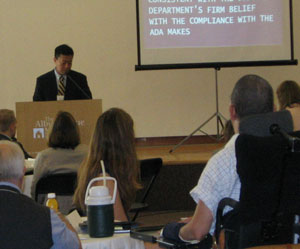 An accessible meeting presentation ensures that all participants have equal access to the meeting's content. Auxiliary aids and services bridge communication between people who are deaf or have hearing loss and people who are hearing so that each can understand the other. Assistance may include qualified sign language and oral interpreters, assistive listening systems, and realtime captioning (also called CART -- communication access realtime translation or computer-aided realtime translation) services. Accessible exchange of information for people who are blind or have low vision may require that printed materials are provided in alternate formats (e.g., Braille, large print, on CD) or that notetakers are provided. The auxiliary aids and services needed at any one event will depend both on the participants and the meeting's format, content, and handouts.
An accessible meeting presentation ensures that all participants have equal access to the meeting's content. Auxiliary aids and services bridge communication between people who are deaf or have hearing loss and people who are hearing so that each can understand the other. Assistance may include qualified sign language and oral interpreters, assistive listening systems, and realtime captioning (also called CART -- communication access realtime translation or computer-aided realtime translation) services. Accessible exchange of information for people who are blind or have low vision may require that printed materials are provided in alternate formats (e.g., Braille, large print, on CD) or that notetakers are provided. The auxiliary aids and services needed at any one event will depend both on the participants and the meeting's format, content, and handouts. 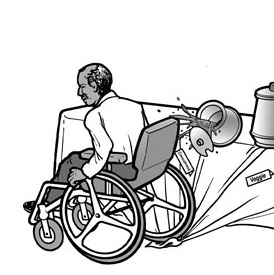


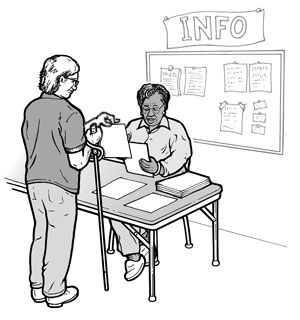
 On the day of the meeting, introduce the service providers to the participants who requested the services. Talk with them all to ensure that seating, lighting, and equipment are in place for effective delivery of the services. For example, people who are deaf or have hearing loss need to see the interpreter throughout the meeting. If the room lights are lowered for audiovisual presentations, separate lighting on the interpreter may be needed. Ensure that assistive listening systems are in working order with sufficient battery power for the entire meeting.
On the day of the meeting, introduce the service providers to the participants who requested the services. Talk with them all to ensure that seating, lighting, and equipment are in place for effective delivery of the services. For example, people who are deaf or have hearing loss need to see the interpreter throughout the meeting. If the room lights are lowered for audiovisual presentations, separate lighting on the interpreter may be needed. Ensure that assistive listening systems are in working order with sufficient battery power for the entire meeting. 